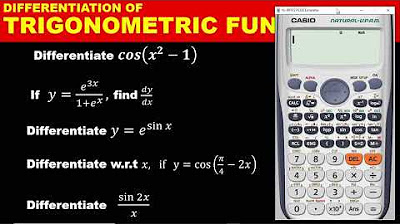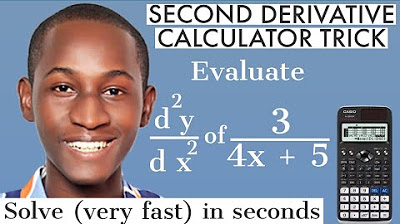Derivatives Calculator Techniques | Engr. Yu Jei Abat | Ten Examples | Engineering Board Exam
TLDRThis instructional video script offers an in-depth guide on utilizing calculator techniques for solving engineering board exam problems, specifically focusing on the differentiation of various mathematical functions. The speaker emphasizes setting the calculator to 'degree' mode for transcendental functions and demonstrates step-by-step methods to differentiate functions like square roots, exponentials, and trigonometric expressions. By comparing calculated derivatives with multiple-choice options, the script aims to simplify the process for students, ensuring they can confidently tackle board exam questions even without memorizing differentiation formulas.
Takeaways
- 📚 The video is a tutorial on using calculator techniques to evaluate the derivative of functions for engineering board exams.
- 🔍 Ensure the calculator is in the correct mode, specifically 'degree mode', for transcendental functions involved in derivative calculations.
- 📈 Demonstrates how to differentiate a function using a calculator by inputting a small value for x, such as 0.1, 0.3, or 0.5, to represent a small change.
- 🔑 Explains the process of using the calculator's derivative function, denoted as 'd/dx', to find the derivative of a given function.
- ✅ Emphasizes the importance of comparing the calculator's result with multiple-choice answers to identify the correct derivative formula.
- 🔢 Provides a step-by-step method to differentiate various types of functions, including transcendental and inverse hyperbolic functions.
- 📝 Highlights the need for careful input, especially with parentheses, to avoid syntax errors when using the calculator for differentiation.
- 📉 Discusses the use of the calculator to verify answers by comparing the calculated derivative with the provided choices in a multiple-choice format.
- 📌 Stresses the utility of calculator techniques for solving derivatives in a board exam setting, even if one forgets the differentiation formulas.
- 📝 Suggests storing intermediate results in calculator variables for easy comparison and verification against multiple-choice options.
- 🎓 Concludes with an encouragement to practice these calculator techniques to aid in passing the engineering board exam.
Q & A
What is the main topic of the video?
-The main topic of the video is about using calculator techniques for evaluating the derivative of certain functions in the context of engineering board exams.
Why is it important to set the calculator to the correct mode before evaluating derivatives?
-It is important to set the calculator to the correct mode, specifically the 'region mode', to handle transcendental functions that may be involved in the derivative calculations.
What is the first function given in the script to differentiate using a calculator?
-The first function to differentiate is y = square root of (3 - 2x^2).
Why is a small value of x used when differentiating without a given value?
-A small value of x is used to represent the concept of a derivative as a small change in the function, and it helps to approximate the derivative at a specific point.
How does the script suggest to verify the correctness of a derivative calculated by a calculator?
-The script suggests verifying the correctness by comparing the calculator's result with the possible choices provided in a multiple-choice question, using the same value of x used in the derivative calculation.
What is the process for differentiating a function with respect to a variable other than x, such as u?
-The process involves transforming the variable u into x, since calculators typically only have differentiation functions with respect to x, and then performing the differentiation as usual.
Why is it necessary to be careful with parentheses when inputting functions into a calculator?
-Parentheses are necessary to correctly group terms and functions, especially in the context of calculators, to ensure the correct order of operations and to avoid syntax errors.
What is the significance of storing the calculated derivative in a variable for comparison?
-Storing the calculated derivative in a variable allows for easy comparison with the possible answers in a multiple-choice question, to determine which answer matches the derivative of the function.
How does the script demonstrate the use of calculator techniques for different types of functions?
-The script demonstrates the use of calculator techniques by walking through the differentiation of various types of functions, including transcendental, inverse transcendental, and functions involving trigonometric and logarithmic operations.
What is the final advice given by the speaker in the script regarding the use of calculator techniques for the board exam?
-The final advice is to use the calculator techniques learned in the video to solve problems, especially in a board exam setting, and to practice these techniques to ensure readiness for the exam.
Outlines
📚 Introduction to Calculator Techniques for Derivatives
This paragraph introduces the topic of using calculator techniques to evaluate derivatives for engineering board exams. The speaker emphasizes the importance of setting the calculator to 'function' mode for handling transcendental functions. The first example involves differentiating the function y = √(3 - 2x^2) using a calculator, inputting a small value for x to find the derivative. The process involves using the derivative function on the calculator and comparing the result with multiple-choice answers to identify the correct derivative formula.
🔍 Derivative Calculations and Comparisons
The speaker continues with more examples of using a calculator to find derivatives of various functions, such as (x + 3)(x + 1)^3 - x^3, and compares the results with given multiple-choice answers. The method involves careful input of functions into the calculator, using small values for x, and checking if the calculated derivative matches any of the provided answer choices. The correct answers are identified through this process, and the importance of using small numbers for the x value is highlighted to simulate the concept of a derivative as a small change.
📈 Derivatives of Functions with Different Variables
This section discusses how to handle derivatives when the function involves a variable other than x, such as u in the function h = π^(2u). The speaker demonstrates how to substitute u with x for calculator input and uses an example with the natural logarithm function to find the derivative. The process is shown for a specific value of x, and the result is compared with the answer choices to determine the correct derivative formula.
📉 Advanced Derivative Problems and Techniques
The paragraph delves into more complex derivative problems, including functions with square roots, sines, and inverse hyperbolic functions. The speaker uses the calculator to differentiate these functions by carefully inputting the function and a small value for x. Each derivative is then compared with the answer choices to find the correct formula. The explanation includes the use of the product rule and handling of inverse trigonometric functions, emphasizing the calculator's role in solving these problems.
🎓 Final Thoughts on Calculator Techniques for Exams
In the concluding paragraph, the speaker summarizes the importance of learning calculator techniques for solving derivative problems, especially for engineering board exams. They express hope that the viewers have learned valuable skills from the video and will apply these techniques to pass their exams. The speaker also mentions that they will provide the answer to a final problem in the comments section, encouraging viewers to test their understanding of the taught techniques.
Mindmap
Keywords
💡Engineering Board Exam
💡Calculator Techniques
💡Derivative
💡Mode
💡Transcendental Function
💡Differentiate
💡Square Root
💡Parentheses
💡Variable
💡Multiple Choice
💡Product Rule
💡Inverse Hyperbolic Function
Highlights
Introduction to calculator techniques for evaluating derivatives in engineering board exams.
Ensuring the calculator is in the correct mode for transcendental functions.
Differentiating the function y = √(3 - 2x^2) using a calculator without given x values.
Using small values of x to represent the concept of a derivative as a small change.
Storing intermediate results in variables for comparison in multiple choice questions.
Comparing calculated derivatives with multiple choice answers to find the correct formula.
Differentiating a function with a variable other than x by substituting it with x.
Using the calculator to differentiate composite functions and inverse trigonometric functions.
Applying the product rule for differentiation using the calculator.
Dealing with syntax errors in calculator input by carefully using parentheses.
Differentiating functions involving natural logarithms and exponentials.
Using calculator techniques to solve for derivatives in multiple choice exam questions.
The importance of knowing how to differentiate manually as well as using a calculator.
Demonstrating the process of differentiating functions raised to powers of themselves.
Calculating derivatives of functions with transcendental inverse functions like arctan.
Differentiating functions involving inverse hyperbolic functions.
Final words of encouragement for using calculator techniques to pass the board exam.
Transcripts
Browse More Related Video

Calculator Techniques FOR BOARD EXAM - Evaluating Functions and Simplifying Expressions 10 EXAMPLES

Third Derivative Calculator Technique For ENGINEERING BOARD EXAM | ENGR. YU JEI ABAT | #ABATANDCHILL

DIFFERENTIATION PART 3: HOW TO DIFFERENTIATE TRIGONOMETRIC FUNCTION WITH THE CALCULATOR

LIMITS CALCULATOR TECHNIQUES - DIFFERENTIAL CALCULUS | ENGINEERING BOARD EXAM REVIEW | YU JEI ABAT

FAST STEPS TO SOLVE SECOND DERIVATIVE USING CALCULATOR: fx-991 ex | double differentiation

Trigonometry Calculator Techniques by Engr. Yu Jei Abat | #AbatAndChill
5.0 / 5 (0 votes)
Thanks for rating: